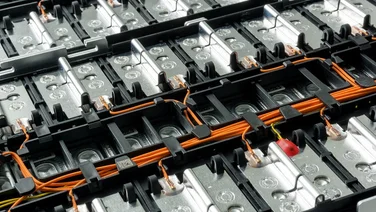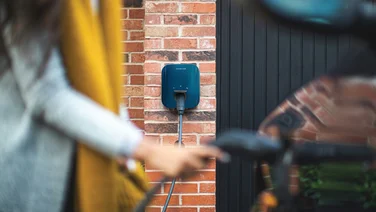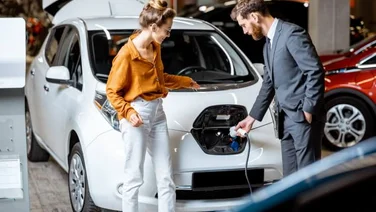- Lithium, nickel, and cobalt are three of the key minerals in EV batteries
- Lithium-ion batteries account for 60% of the EV market share
- EV mineral mining has been linked to environmental degradation
The demand for electric vehicles (EVs) is increasing, which is also causing the price of EV chargepoints and electric cars to be lower than ever.
With EVs becoming more common, you might be wondering what minerals are in the batteries they run on.
In this article we’ll go over the common types of EV batteries, what minerals are in them, and where those minerals come from. We’ll also explain the environmental impacts of mineral mining.

Common types of EV batteries
There are three main types of electric vehicle (EV) batteries in use today: lithium-ion batteries, nickel-metal hydride batteries, and lithium iron phosphate batteries.
We’ll explain the difference between these three types of batteries in the following sections.
Lithium-ion batteries
Lithium-ion batteries (also known as Li-ion) are the most commonly used type of electric battery, accounting for around 60% of market share in 2022, according to the International Energy Agency (IEA).
They’re popular because they have a high energy density (meaning they can hold a lot of power whilst taking up little space), high heat resistance, and high energy efficiency.
Nickel-metal hydride batteries
Nickel-metal hydride (NiMH) batteries are mostly used in hybrid EVs (HEVs). Even though they’re more durable than lithium-ion batteries, they’re less popular because they’re expensive to manufacture and not as heat resistant.
For this reason, some HEV manufacturers have switched to lithium-ion batteries. However, Toyota, which has 60% of the global HEV market share, still uses nickel-metal hydride, and has not announced any plans to switch.
Lithium iron phosphate batteries
The lithium iron phosphate (LFP) battery is the new kid on the block. LFP batteries are gaining popularity because they’re less expensive to produce than the previous two types. Plus, they don’t use certain metals, such as cobalt or nickel, – the mining of which has been linked to human rights violations.
China is the current leader in LFP production, supplying 90% of global components for them. But with US-based EV manufacturing giant Tesla announcing plans to switch from Li-ion batteries to LFP batteries, this could soon change. In 2022 alone, LFP batteries made up 30% of all EV batteries used by Tesla, up from 20% in 2021.
Key minerals in EV batteries
EV batteries are complex structures that include various minerals, with the exact mix and quantities varying depending on the battery type.
Here are the minerals that are make up the biggest portions of EV batteries:
- Lithium
- Cobalt
- Nickel
- Manganese
- Iron
- Graphite
- Aluminium
- Copper
- Steel
Both lithium-ion batteries and nickel-metal hydride batteries contain manganese, nickel, and graphite, but in different quantities.
The difference between the two is that lithium-ion batteries contain lithium, whereas nickel-metal hydride batteries don’t. With the ongoing lithium shortage, this gives nickel-metal hydride batteries an edge over other types.
However, nickel-metal hydride batteries are still currently expensive to produce, since they contain rare-earth metals, such as lanthanum, cerium, and neodymium.
LFP batteries – the newest kind of EV battery – contain primarily lithium, iron, graphite, and aluminium, which are all common and widely mined metals.

Where do EV battery minerals come from?
Where EV battery minerals come from depends on the mineral itself, but most are obtained and extracted by mining hard rock.
We’ll get into the details of how and where each mineral is obtained in the next few sections.
Lithium
There are two methods for extracting lithium. The first method is via brine reservoirs (called ‘salars’), where salt water is left to evaporate over several months. This method is used in countries, such as Chile – which accounted for 30% of global lithium production in 2022 – China, and Argentina.
The second method for extracting lithium is hard-rock extraction, otherwise known as mining. This is mainly done in Australia, which accounted for 47% of global production in 2022, producing 61,000 tonnes of lithium – for context, that’s equivalent to around 5,080 double-decker buses.
Smaller extraction operations also exist in Brazil, Portugal, China, and various southern African countries.
The UK is also set to open its own mine, after finding significant lithium reserves in Cornwall.
Cobalt
Cobalt is obtained through mining, with 70% of the global supply coming from the Democratic Republic of Congo. Other countries that produce cobalt include Russia, Australia, and the Philippines.
Critically, most cobalt mining – 98% of it – is a byproduct of other mining operations for minerals, such as nickel or copper, according to the Cobalt Institute.
Nickel
Nickel is mined in over 25 countries, and about 11% of all nickel mined is used in batteries, according to the Nickel Institute.
The largest producer of nickel is Indonesia, which produced around 1.6 million tonnes of the material in 2022. This is followed by the Philippines, Russia, New Caledonia, and Australia. Other moderate nickel producers include Canada, China, the United States, and Brazil.
Manganese
Manganese is also obtained through mining. The top producer is South Africa, which accounted for around 37% of global production in 2021. Other large producers of manganese include Gabon, Australia, China, and Ghana.
Iron
Iron is a very common mineral, and is mined in around 50 countries, according to the US National Minerals Center.
Australia and Brazil are the top two producers, with Australia producing around 880,000 tonnes of iron in 2022, and Brazil producing 410,00 tonnes. Both countries account for around two-thirds of global iron exports.
Other top producers of iron include China, India, and Russia.
Graphite
Graphite is also a mined mineral, with China being the largest producer of natural graphite – responsible for almost 80% of world production.
By comparison, the other top producers, Brazil and Mozambique, accounted for less than 10% of global production combined.
What is the impact of EV mineral mining on the environment
EV mineral mining can have several negative impacts on the environment, including:
- Deforestation and soil erosion
- Water and air pollution
- Increased greenhouse gas emissions
- Human rights abuses
We’ll go into more detail about each of these negative impacts in the following sections.
Deforestation and soil erosion
Large-scale mining operations can cause massive disruption to local nature. In fact, mining is currently the fourth-largest driver of deforestation, according to the World Wide Fund for Nature (WWF).
All this can have ripple effects on local ecosystems. For example, studies show that mining increases the risk of soil erosion (when the top layer of soil wears away), and decreases soil fertility (fertile soil means plants can easily grow on it).
This can negatively impact local wildlife and human populations, putting their home at risk of flooding, and making it difficult for them to cultivate food.
Water and air pollution
Mining also creates waste in the form of metal particles and chemicals used in the extraction process.
Chemicals, such as cyanide, arsenic, lead, and mercury, are all byproducts of mining and refining. These can seep into local water supplies, and get carried in the air in the form of dust.
Unfortunately, the chemicals used in mining can cause a range of negative health effects in humans and wildlife – from kidney problems, to cancer, and even death.
Increased greenhouse gases
Mining also contributes to global greenhouse gas (GHG) emissions. Afterall, it’s an energy-intensive operation, most of which is powered by fossil fuels. The metals and mining industry alone accounts for around 4– 7% of global GHG emissions.
Human rights abuses
Aside from environmental impacts, mining can also have negative social impacts. The most well-known example of this is cobalt mining.
Organisations, including Amnesty International, have reported numerous human rights abuses in mines in the Democratic Republic of Congo, which include child labour, poor pay, and dangerous working conditions.
Summary
Minerals play a vital role in the functioning of EVs, but mining them has its own share of negative environmental and social impacts.
As EVs become more common, it’s important to address these issues, as they’ll only get worse as demand for EV battery minerals increases. Ensuring that mining is done safely, with minimal impact on local communities and the environment, is a core step in the green transition.
If all this seems bleak, remember that EVs are still far better for the environment than petrol cars, since they create zero emissions after production. You can find out just how green electric cars are by reading our in-depth assessment.






